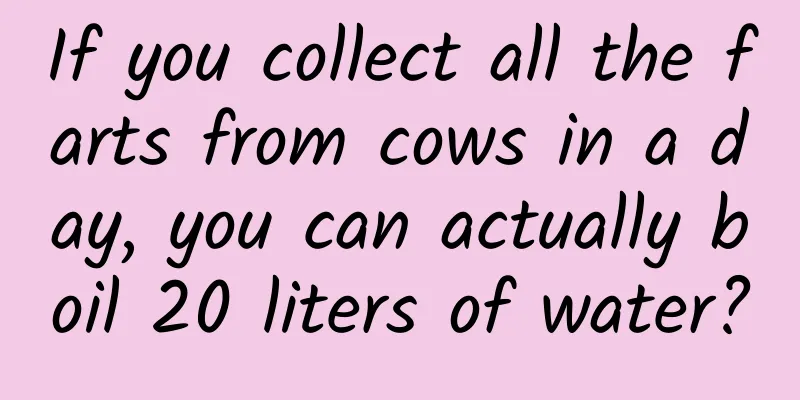If you collect all the farts from cows in a day, you can actually boil 20 liters of water?

|
Global warming has exacerbated glacier melting and sea level rise, which has risen by 3.7 mm per year from 2006 to 2018. It has also led to more frequent and more intense extreme weather events, such as hurricanes and heat waves, posing a serious threat to ecosystems and human survival. But what does what cows eat have to do with global warming? You're right, it really does. Let's find out today. Greenhouse gases, what do they have to do with cows? We know that an important factor in global warming is greenhouse gas emissions, such as carbon dioxide (CO₂), methane (CH₄) and nitrous oxide (N₂O), which can cause global warming by absorbing and storing heat. According to the Intergovernmental Panel on Climate Change (IPCC), human activities have caused the global temperature to rise by about 1.1°C since industrialization, with greenhouse gas emissions being the main driving factor. According to the International Energy Agency (IEA), the energy sector is the largest source of greenhouse gas emissions, accounting for 73.2% of global emissions, of which the electricity and heating sectors account for 42%. Agricultural activities, such as animal husbandry and rice cultivation, are important sources of methane and nitrous oxide, accounting for 17% of global emissions . Industrial processes such as cement production and chemical manufacturing account for about 20% of global carbon dioxide emissions. In addition, waste treatment and landfills produce about 3% of methane emissions. These emission sources interact with each other and jointly promote climate change. As mentioned above, agricultural activities account for 17% of methane emissions, of which animal husbandry itself contributes 14.5% of global greenhouse gas emissions, a large part of which comes from methane emitted by cows farting and burping. Therefore, cows and greenhouse gas emissions are really inseparable. Why do ruminants such as cows produce methane during digestion? This is mainly because microorganisms in their stomachs, especially in the rumen, perform anaerobic fermentation when breaking down cellulose and other carbohydrates. One of the byproducts of this biochemical reaction is methane, which is emitted into the atmosphere through burping and farting. Copyright images in the gallery. Reprinting and using them may lead to copyright disputes. Methane emissions vary depending on the type of animal, feed type and feeding method. For example, dairy cows can emit about 250-500 liters of methane per day, accounting for about 20% of the total methane emissions from ruminants. In order to reduce this emission, scientists recommend adjusting feed composition and improving breeding methods to slow down methane production, thereby reducing the impact of animal husbandry on climate warming. How to make cows burp less and fart less? Given people's demand for beef and milk, it is not realistic to reduce emissions by not raising cattle, but people can still think of other ways. In 2021, according to a study by the University of California, Davis, scientists added a type of red algae (Asparagopsis taxiformis) to the diet of 21 cows over a period of 5 months, accounting for only 0.2% of the total feed, and the results showed that methane emissions were reduced by up to 82%. In December 2024, scientists at the University of California, Davis published new research results in the Proceedings of the National Academy of Sciences. The study was conducted on semi-arid pastures in Montana, USA, to explore the effects of adding granular supplements containing red algae on methane emissions from beef cattle. 24 cattle were randomly divided into a control group and a treatment group. The treatment group's feed was supplemented with 20% seaweed supplements, which contained bromoform that inhibits methane production. The methane, carbon dioxide and hydrogen emissions of the cattle were measured by an emission monitoring system, and body weight and feed intake were recorded. The results showed that methane emissions in the treatment group decreased by 37.7%, from 182 grams/day to 138 grams/day. Research published in the Proceedings of the National Academy of Sciences (Source: Reference 1) At present, as long as the dosage of bromoform is strictly controlled and its metabolism and residues are continuously monitored, it is safe as a feed additive, but more research is needed to support these conclusions, especially in terms of long-term effects and processing by-products. Adding algae to feed can reduce methane emissions (Source: Photo by the author) The study also found that hydrogen emissions in the treatment group increased significantly, while carbon dioxide emissions decreased slightly. This suggests that the inhibition of the methane production pathway changes the metabolic process in the rumen. Overall, this study validates the effectiveness of bromoform-containing seaweed supplements in reducing methane emissions under actual pasture conditions, providing a practical solution for achieving sustainable animal husbandry. This method does not significantly affect the health, weight gain or milk production of cattle, and the increase in feeding costs is also within an acceptable range, which is highly feasible. Scientists believe that if this technology is promoted to the global livestock industry, it will not only significantly reduce methane emissions, but also achieve more sustainable livestock production while meeting global demand for milk and beef. In addition, compared with traditional emission reduction measures, the production and application of seaweed supplements have a lower technical threshold, which is conducive to promotion to low-income areas. Of course, seaweed is not the only option for reducing emissions from cattle . For example, starting from the way ruminants produce methane, we can reduce methane emissions by adjusting the feed structure, optimizing feeding management, selecting animals of suitable breeds and physiological states, and using plant secondary metabolites (such as tannins, saponins and essential oils), microecological preparations (such as yeast, lactic acid bacteria and Bacillus subtilis and other microorganisms), organic acids (such as malic acid, fumaric acid and tannic acid), inorganic compounds (3-NOP) and algae (seaweed and microalgae). Studies have found that plant secondary metabolites, such as tannins, saponins, flavonoids and essential oils, have methane emission reduction effects. Tannins can bind to the polysaccharides and protein components on the outer membrane of microorganisms in the rumen, thereby reducing the activity of rumen microorganisms and reducing the production of methane gas. Other experiments have shown that the use of concentrated tannins in goats can reduce methane by 50%. In in vitro batch culture, as the saponin dosage increases, methane emissions decrease by 29% and the number of protozoa decreases by 50%. Cow fart can actually be recycled? In addition to reducing methane emissions from cattle by changing feed ingredients by adding seaweed, directly collecting methane emitted by cattle and using it is also an interesting and potential solution. As early as 2014, the National Institute of Agricultural Technology (INTA) of Argentina proposed an innovative study to wear plastic backpacks for cattle and connect them to their largest digestive organ, the rumen, through tubes to extract methane. According to research data, each cow can collect about 300 liters of methane per day, which can be used as a clean energy source after being processed. You may ask, what can 300 liters of methane be used for? Let's do a simple calculation. What is the concept of 300 liters of methane? We all know that the main component of natural gas in our homes is methane. Let's use methane to boil water as an example. Let's do a calculation. The known conditions are as follows: Volume of methane: 300 liters = 0.3 cubic meters. Density of methane: 0.656 kg/m³. Heat of combustion of methane: 55.5 MJ/kg. Specific heat capacity of water: 4.186 kJ/(kg·℃). Heating efficiency: Assumed to be 60%. Initial water temperature: 20°C. Boiling point of water: 100℃. Through the following steps we can calculate that if a cow farts 300 liters a day, this amount of methane can boil nearly 20 liters of water! 300 liters of methane can boil nearly 20 liters of water (Source: Author's calculation) Although this technology is still in the proof-of-concept stage, its application prospects are particularly attractive in farms in remote areas. Argentina is an important beef producer in the world, with more than 50 million cattle. If this technology can be promoted to large-scale application, it will significantly reduce the impact of livestock methane emissions on the environment. Summarize Methane emitted by cows when they fart and burp may seem like a harmless phenomenon in daily animal husbandry, but in fact its impact on climate change cannot be ignored. Scientists have provided effective solutions to reduce greenhouse gas emissions through innovative technical means, such as improving feed composition, adding seaweed supplements, and developing methane collection equipment. These studies not only verify the feasibility of methane emission reduction at the theoretical level, but also provide valuable references for practical applications. Perhaps in the future, as these technologies mature and are promoted, we will be able to significantly reduce greenhouse gas emissions without sacrificing livestock production efficiency. References [1]Meo-Filho, Paulo, John F. Ramirez-Agudelo, and Ermias Kebreab. "Mitigating methane emissions in grazing beef cattle with a seaweed-based feed additive: Implications for climate-smart agriculture." Proceedings of the National Academy of Sciences 121.50 (2024): e2410863121. [2]Roque, Breanna M., et al. "Red seaweed (Asparagopsis taxiformis) supplementation reduces enteric methane by over 80 percent in beef steers." Plos one 16.3 (2021): e0247820. [3] Li Gaolong, Wu Zhaohai, Zhao Liansheng, et al. Research progress on methane emission reduction in ruminants[J]. Chinese Journal of Animal Husbandry and Veterinary Medicine, 2024, 51(11): 4812-4823. DOI: 10.16431/j.cnki.1671-7236.2024.11.016. [4]Qiu, Jian-qiang, et al. "Research progress in regulation of tannins on intestinal microbiota of animals." (2023): 772-781. [5]Waghorn, Garry C., and Warren C. McNabb. "Consequences of plant phenolic compounds for productivity and health of ruminants." Proceedings of the Nutrition Society 62.2 (2003): 383-392. [6]Animut, G., et al. "Methane emission by goats consuming diets with different levels of condensed tannins from lespedeza." Animal Feed Science and Technology 144.3-4 (2008): 212-227. [7]https://science.nasa.gov/climate-change/causes/ [8] https://www.fao.org/ [9]https://openknowledge.fao.org/handle/20.500.14283/cc9029en Planning and production Author: Denovo team Review丨Shi Wenqing, Senior Animal Husbandry Specialist at Beijing Animal Husbandry Station Planning丨Ding Zong Editor: Ding Zong Proofread by Xu Lai and Lin Lin The cover image and the images in this article are from the copyright library Reprinting may lead to copyright disputes |
<<: What pots and containers can be used to bake delicious sweet potatoes?
>>: Using leftover food to generate electricity! The transformation of kitchen waste
Recommend
Amblyopia = myopia? Is it okay if you can see well? West China experts: Four pitfalls of amblyopia, don't step into them!
Does your baby have these strange "little ac...
Master these seven principles to improve user login success rate!
TCC Recommendation: Hello everyone, this is TCC T...
The landing page conversion rate is low, and 90% of the traffic is wasted?
How do you design your landing pages? In bidding,...
China Automobile Dealers Association: China's auto dealer inventory warning index is 49.5% in June 2022
On June 30, 2022 , the latest issue of the "...
Popular Science Let Me Tell You丨There really is "bread" growing on trees! Have grains and fruits quietly "merged"?
Spread scientific ideas and promote scientific sp...
What is the difference between a Chinese businessman buying masks priced at 10 million yuan and a Chinese businessman buying masks priced at 10 million yuan?
Chinese businessman buys masks worth 10 million y...
A few branches serve as a nest, and the bird lays eggs anywhere. This bird is really a jerk.
Some time ago, citizens often shared interesting ...
Iris recognition, gait recognition...the best cryptography is hidden in the human body!
When it comes to passwords and cryptography, peop...
How to do a good job in the market for a new APP: cheating, deceiving, kidnapping, deceiving, stealing
In the mobile game market, if a marketer wants to...
Build a super fast computer for deep learning for less than $1,000: Continue the exploration of deep learning and cheap hardware!
[[192381]] Yes, you can run TensorFlow on a $39 R...
Mobile business revenue under pressure, LG and Samsung compete for high-end TV profits
High-end TVs have brought a warm touch to the per...
When we eat fish, are we eating our ancestors?
It is the dream of many researchers to be able to...
This smell is really "nan"! The heather flower, which is on the hot search list, is actually full of treasures
There is a popular saying: "If you can't...
Piles of mysterious slime are falling from the sky?! It is said to have magical effects. What is this weird thing?
For hundreds of years, people around the world ha...
Can you lose weight without dieting or exercising? Chinese scientists have developed a new method
#Chinese scientists discover new way to lose weig...









